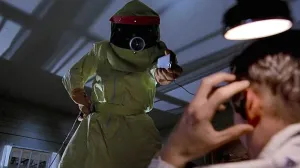Behind two of cinema’s most iconic extraterrestrials stands a single creative genius whose mechanical wizardry breathed life into both nightmares and dreams. While H.R. Giger’s biomechanical artwork may have conceptualized the terrifying Xenomorph in Alien and Steven Spielberg might have envisioned the lovable alien from E.T. the Extra-Terrestrial, neither creature would have captivated audiences without the mechanical ingenuity of Carlo Rambaldi. This Italian special effects maestro, whom Spielberg affectionately dubbed “E.T.’s Geppetto,” created the mechanical systems that gave both extraterrestrials their uncanny lifelike qualities. Despite representing opposite ends of the emotional spectrum – one designed to terrify, the other to endear – these cinematic aliens share a common DNA through Rambaldi’s extraordinary craftsmanship.
Videos by ComicBook.com
Rambaldi’s path to Hollywood began in his native Italy, where his artistic education at the Academy of Fine Arts in Bologna blended with a passion for mechanics and anatomy. His early career in Italian cinema established his reputation for creating convincingly realistic effects – so realistic, in fact, that director Lucio Fulci nearly faced prison time when authorities believed Rambaldi’s fabricated mutilated dogs in1971’s A Lizard in a Woman’s Skin were real animals. This incident marked the first time a special effects artist had to legally prove his work wasn’t authentic, foreshadowing the revolutionary impact his creations would have on cinema.
From Nightmare to Dream Machine

For Alien, Rambaldi focused on giving functionality to Giger’s nightmarish design, specifically crafting the Xenomorph’s mechanical head. His creation featured a sophisticated system of cables and levers controlling approximately 900 moving parts that operated the creature’s jaw, inner mouth, and notoriously extending second set of teeth.
The intricate mechanisms allowed for the Xenomorph’s signature attack – the horrifying emergence of its secondary jaw – to be executed with terrifying precision. Despite Rambaldi’s complaint that director Ridley Scott utilized “but twenty” of the “one hundred possibilities” his mechanisms offered, his work established the Xenomorph as one of cinema’s most memorable monsters.
Three years later, Rambaldi’s talents were enlisted for a completely different extraterrestrial encounter. After Spielberg spent $700,000 on unsatisfactory alien prototypes for E.T., he turned to Rambaldi, who created three different E.T. torsos with varying capabilities. The most sophisticated version featured 86 points of movement throughout its body, while its electronic head could perform 35 distinct facial expressions.
Far from the nightmare fuel of the Xenomorph, E.T.’s design incorporated softer inspirations – including, intriguingly, elements from Rambaldi’s own 1952 painting Donne del Delta. The creature required twelve operators to bring it to life, but the results were so convincing that audiences emotionally connected with what was essentially an elaborate puppet.
[RELATED – Aliens Has a Hilarious Xenomorph Detail That I Never Noticed]
The Human Touch in Alien Design

What makes Rambaldi’s contributions particularly remarkable was his insistence on mechanical ingenuity over shortcuts. Working before the CGI revolution, he created tactile, present creatures that actors could interact with authentically. His preference for practical effects gave both E.T. and the Xenomorph a physical reality that digital effects often struggle to replicate. Rambaldi once noted that computer-generated effects had diminished the “mystery” and “curiosity” viewers once felt, lamenting that “the charm has disappeared.”
This commitment to mechanical authenticity earned Rambaldi three Academy Awards: a Special Achievement Award for 1976’s King Kong and Best Visual Effects Oscars for both Alien and E.T. His mechanical masterpieces represented the pinnacle of pre-digital special effects, creating memorable movie moments through craftsmanship rather than computer code.
David Lynch, who worked with Rambaldi on Dune, once observed that the artist seemed to put something of himself into all his creations. Indeed, there’s a peculiar poetry in how the same hands crafted both cinema’s most terrifying monster and its most beloved alien visitor. While generations of viewers might never realize these iconic extraterrestrials share a creative lineage, both creatures continue to demonstrate how practical effects, when executed with artistic vision and mechanical ingenuity, can create enduring movie magic that transcends technological limitations.
Rambaldi’s legacy lives on not just in museum displays (the Xenomorph’s jaw is exhibited at the Smithsonian) but in the emotional impact these creatures continue to have. In a cinematic landscape now dominated by digital effects, the tangible craftsmanship behind E.T. and the Xenomorph reminds us that sometimes the most effective movie magic comes not from algorithms, but from an artist’s hands.








